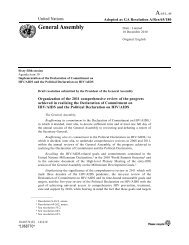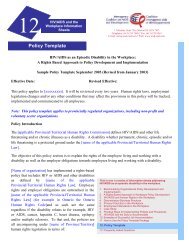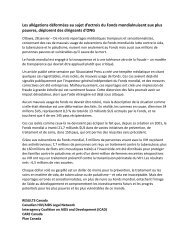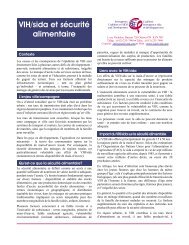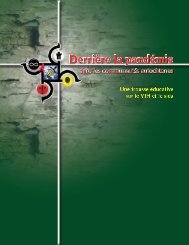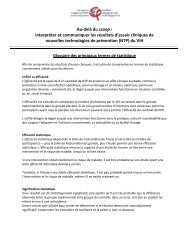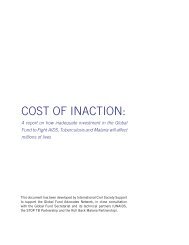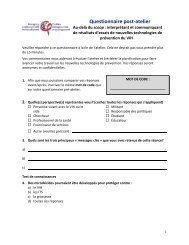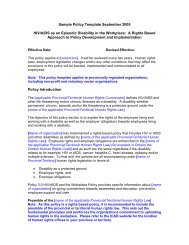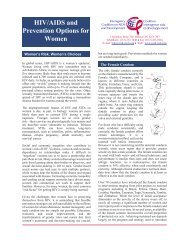Behind the Pandemic in Aboriginal Communities - Interagency ...
Behind the Pandemic in Aboriginal Communities - Interagency ...
Behind the Pandemic in Aboriginal Communities - Interagency ...
- No tags were found...
You also want an ePaper? Increase the reach of your titles
YUMPU automatically turns print PDFs into web optimized ePapers that Google loves.
Stage 3 - Rapids and CanoesActivity Overview1 M<strong>in</strong>uteActivity Rules4 M<strong>in</strong>utesThis activity is an adaptation of <strong>the</strong> popular children’s gameSnakes and Ladders, which was created <strong>in</strong> ancient India.40 M<strong>in</strong>utesWe have adapted <strong>the</strong> ma<strong>in</strong> ideas of Snakes and Ladders to providean opportunity to practise us<strong>in</strong>g a population health lens tounderstand <strong>the</strong> factors that contribute to HIV vulnerability andresiliency among Aborig<strong>in</strong>al peoples.The process of <strong>the</strong> game and <strong>the</strong> opportunities for discussion aremore important for our collective learn<strong>in</strong>g than is be<strong>in</strong>g <strong>the</strong> first toreach <strong>the</strong> 100 th square.There will be 5 players on <strong>the</strong> board; each player can be an <strong>in</strong>dividualor a small team to accommodate different group sizes.Players will take turns roll<strong>in</strong>g <strong>the</strong> dice to see how many squares<strong>the</strong>y can move forward (maximum of 6 spaces).If you land on a square with <strong>the</strong> top of a rapid, you slide down to<strong>the</strong> square at <strong>the</strong> bottom of <strong>the</strong> rapid and are given a Vulnerabilitycard with <strong>the</strong> story of someone <strong>in</strong> your community who may beexposed to <strong>the</strong> HIV virus or who is currently liv<strong>in</strong>g with HIV.If you land on a square with <strong>the</strong> bottom of a canoe, you climb upto <strong>the</strong> square at <strong>the</strong> top of <strong>the</strong> canoe and are given a Resiliencycard. Resiliency cards describe a characteristic or quality of yourcommunity that promotes <strong>the</strong> health and wellbe<strong>in</strong>g of communitymembers.Whenever anyone lands on a rapid or canoe, we will stop for adiscussion. We will use one of four frames to analyze <strong>the</strong> card:• Individual: The thoughts, feel<strong>in</strong>gs, needs, and actions of ma<strong>in</strong>character.• Family: The relationships, dynamics, and communication among<strong>the</strong> characters.• Community: The relationships, support structures, and <strong>in</strong>frastructureamong <strong>the</strong> <strong>in</strong>dividuals and family members.• Systemic: The overarch<strong>in</strong>g structure under which communitiesmust exist, <strong>in</strong>clud<strong>in</strong>g large systems such as education, justice,and health services.After <strong>the</strong> activity, you will have <strong>the</strong> opportunity to fur<strong>the</strong>r exam<strong>in</strong>e<strong>the</strong> <strong>in</strong>formation <strong>in</strong> <strong>the</strong> cards.Facilitator’s Note:This activity is <strong>in</strong>tendedto encouragedialogue among <strong>the</strong>participants that broadens<strong>the</strong>ir understand<strong>in</strong>gof <strong>the</strong> factors that <strong>in</strong>fluencepeople’s decisionsabout sex and drug use.You should be preparedto ask questions thatencourage participantsto th<strong>in</strong>k critically about<strong>the</strong> issues and dynamicsthat are raised, and toraise key issues yourself.The Facilitator’sNotes on VulnerabilityCards (pages 28-44) andFacilitator’s Notes onResiliency Cards (pages47-56) highlight keyissues with<strong>in</strong> <strong>the</strong> cardsand provide questions tohelp stimulate discussion.Facilitator’s Note:Prepare yourIssue ExplorationTree <strong>in</strong> advance (seebox 2). Your tree should<strong>in</strong>clude <strong>the</strong> roots, trunk,branches and leaves.Facilitator’s Note:The VulnerabilityCards andResiliency Cards aredesigned to fosterdialogue among <strong>the</strong>participants. The cardsdo not provide exactanswers but ra<strong>the</strong>rencourage participantsto draw on <strong>the</strong>ir <strong>in</strong>dividualand collectivewisdom to understand<strong>the</strong> issues.21



